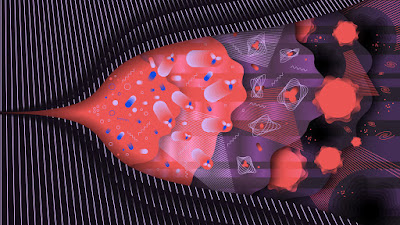 |
| Artwork by Ana Kova |
In particle physics, scientists study the properties of the smallest bits of matter and how they interact. Another branch of physics—astrophysics—creates and tests theories about what’s happening across our vast universe.
While particle physics and astrophysics appear to focus on opposite ends of a spectrum, scientists in the two fields actually depend on one another. Several current lines of inquiry link the very large to the very small.
The seeds of cosmic structure
For one, particle physicists and astrophysicists both ask questions about the growth of the early universe.
In her office at Stanford University, Eva Silverstein explains her work parsing the mathematical details of the fastest period of that growth, called cosmic inflation.
“To me, the subject is particularly interesting because you can understand the origin of structure in the universe,” says Silverstein, a professor of physics at Stanford and the Kavli Institute for Particle Astrophysics and Cosmology. “This paradigm known as inflation accounts for the origin of structure in the most simple and beautiful way a physicist can imagine.”
Scientists think that after the Big Bang, the universe cooled, and particles began to combine into hydrogen atoms. This process released previously trapped photons—elementary particles of light.
The glow from that light, called the cosmic microwave background, lingers in the sky today. Scientists measure different characteristics of the cosmic microwave background to learn more about what happened in those first moments after the Big Bang.
According to scientists’ models, a pattern that first formed on the subatomic level eventually became the underpinning of the structure of the entire universe. Places that were dense with subatomic particles—or even just virtual fluctuations of subatomic particles—attracted more and more matter. As the universe grew, these areas of density became the locations where galaxies and galaxy clusters formed. The very small grew up to be the very large.
Scientists studying the cosmic microwave background hope to learn about more than just how the universe grew—it could also offer insight into dark matter, dark energy and the mass of the neutrino.
What can particles tell us about the cosmos?The minuscule and the immense can reveal quite a bit about each other.Amanda Solliday, Symmetry Magazine
Comments